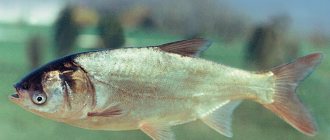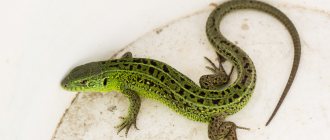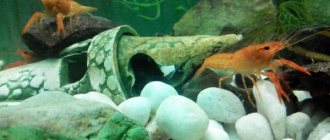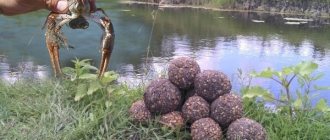The desire for the exotic, as well as the great pleasure of observing the behavior of crabs, is the basis for increased interest in these aquarium inhabitants. At the same time, they can rarely be found in a home or office aquarium: keeping crabs in captivity is difficult and troublesome. However, if you carefully consider the information below, are ready to create comfortable conditions for your pets, and care for them according to all the rules, then the artificial pond will become a “home” for fastidious crabs and a source of your pride.
A crab in an aquarium is truly exotic
To make the requirements for keeping animals in captivity clear and easy to remember, pay attention to the following points:
- The vast majority of crab species live in the coastal strip of seas and oceans, and only a few of them live in freshwater bodies of water.
- Crabs breathe through gills, which means they need water to breathe. While the gills are wet, the crab can be on land and be active. The anatomical structure of the gill apparatus allows it to store moisture for a long time, but if the gills still dry out, the animal dies. Therefore, crabs are not able to live away from water: it must always be at hand, that is, “under the claw.” Traveling along the shore in search of food, crabs from time to time dig deep holes and climb into them. Sea water collects in these depressions. Having “breathed” and filled its gills with life-giving moisture, the crab leaves the hole and goes on “about its business.”
In the wild, crabs dig holes in the coastal sand to replenish moisture in their gills.
- From time to time the crab molts. At the same time, he sheds his old shell and becomes very vulnerable for a while. In order for an animal to tolerate the molting process well and simply remain alive after it, it must eat properly, not overheat, swim in clean water rich in essential salts and microelements, and be able to hide in a safe shelter at the slightest danger.
- Crabs can climb rocks, including almost completely smooth, horizontal and vertical surfaces.
- Animals compete with each other and are ready to desperately defend their prey and territory. Watching their battles is very exciting, but for “claw warriors” such battles become extremely stressful, often ending in self-harm and sometimes the death of one of the rivals. The latter most often happens if a crab that has recently undergone a moult enters the fight.
Crab battles can end sadly
Taking into account the above, there are a number of requirements for keeping crabs in an aquarium. Among them there are strict rules that must be followed, as well as recommendations that it is advisable to adhere to so that the crab lives long, happily and delights you with its funny habits. Most of the requirements are of a general nature, some of them relate more to the content of certain species.
Description
Crabs, or short-tailed crayfish in other words, are a detachment from the subtype Crustaceans, included in the class Higher Crayfish. The remains have been discovered in fossils dating back to the Jurassic period. Now they have hardly changed their appearance and still look like their ancestors. These arthropods are located almost all over the globe.
Crabs are close relatives of crayfish. Their difference is in the external absence of the abdomen, which ends in the tail. They have an abdomen, but it is too small and is located under the chest. The tail would interfere with movement on land.
In these crustaceans, the body size depends on the specific species and ranges from 4 to 35 cm. A distinctive feature from other animals is the presence of strong claws, which are designed for hunting, protecting and cleansing the body. Another 4 pairs of limbs help arthropods move. Small, underdeveloped 2 limbs near the mouth opening help absorb food.
They live in rivers, seas, oceans, rarely on land. They are able to swim in the water column and crawl along the bottom.
The shell color of most species is brown-green. But the body color of different species adapts to their environment. The inhabitants of the sandy bottom are golden beige in color, while those who like to hide in algae are light green. Representatives from coral reefs are colorful.
Arthropods are becoming increasingly common aquarium pets. But they are not very friendly to other underwater inhabitants, even to members of their own family. It is better to keep them alone.
How long do they live?
The lifespan of crabs ranges from 3 to 6 years.
Suitable neighborhood
Crabs are territorial creatures that prefer to be alone. They treat their neighbors poorly and have conflicts even with members of their own family. They also show dissatisfaction with other aquarium inhabitants, trying to catch up and pinch the fish. But, if you want to diversify your aquaterrarium, you can choose suitable pets as neighbors for the crabs. This:
barbs
zebrafish
guppy
mollies
swordtails
macrobrachium shrimp
Types of aquarium crabs
For each type of aquarium crab, certain features of maintenance, feeding and reproduction are preferred. Therefore, when purchasing, be sure to pay attention to what type of crab you are buying.
Let's look at the most common types of crabs.
Red mangrove
The red mangrove species naturally lives in water bodies of the South Asian part. This is one of the types of crabs that live near sandy shores or in creeks with a sandy bottom. “Mangrove” got its name from its favorite place of residence - thickets of mangrove forests.
The color of the shell of this species ranges from burgundy to dark brown. The limbs are the same color as the shell, excluding the claws. The claws are painted a rich red color, becoming lighter towards the end. The size is small - it reaches only a few centimeters in length.
For one individual of the red mangrove species, you will need a small aquaterrarium measuring 35*35 cm and a water height of 10–15 cm. Land should make up at least 20% of the volume of the aquaterrarium. Prefers to live in slightly salted water. Not too sensitive to water hardness and acidity. When keeping several mangrove crabs, conflicts and skirmishes will arise between them.
The pet's place of residence must be covered with a lid. This is a necessary measure because the red mangrove species is distinguished by its agility. He will easily climb up rocks and logs and jump out.
Does not reproduce outside the natural environment.
Dutch
The Dutch species is found in Holland, the Caspian and Azov seas. This species is well suited for inexperienced crustacean keepers. They have no difficulties in maintenance. Their environmental requirements during molting are not too high. Lifespan under optimal conditions is 2.5 – 3 years.
The Dutch species is small in size. An adult specimen grows up to 3–4 cm in length. The carapace is painted in dark shades.
The Dutch crab is a freshwater species and is therefore kept in unsalted water in an aquarium. The look is not too aggressive. Because of this, they are able to live together with other fish. It is desirable that other inhabitants spend most of their time in the upper and middle layers of the water. This will help avoid conflicts. Shows aggression with other representatives and defends its territory.
Proper feeding
Keeping a rainbow crab includes proper feeding. In nature, individuals feed on plant foods - algae, mollusks, fry, insects. The menu for them at home consists of the following products:
- lettuce leaves;
- broccoli;
- Beijing, Brussels sprouts;
- cucumbers;
- zucchini;
- boiled carrots;
- asparagus;
- pumpkin;
- pears, apples;
- red pepper;
- green pea.
They recommend scalded nettles, dandelions, and spinach for crabs. It is better to put the food in one place, but no matter where the food is placed, the pet will still find it.
You can feed arthropods with sinking dry fish food, daphnia, tubifex, shrimp pellets, dried or frozen gammarus, squid meat, mussels, and bloodworms. Sometimes pets are fed pieces of chicken and beef liver.
They love autumn foliage from maple, oak, raspberry trees or calendula, dandelion, clover. Some owners offer them crushed oatmeal and walnuts.
Advice! You should not feed individuals too much or too often. This leads to severe water pollution and poisoning by metabolic products. Plant foods should predominate in the diet. Bananas, potatoes, pasta and fatty foods are not recommended
Pieces of food should be the size of a large pea. It is recommended to feed 3 times a day, give protein food once a week.
Conditions
When keeping a crab in an aquarium, it is important to know the characteristics of their body, daily routine, and dietary preferences. Before purchasing an arthropod pet, you need to weigh the pros and cons, find out information about keeping and caring for them.
Water requirements
A large number of varieties of crustaceans live in salt water bodies. Therefore, the water in the aquaterrarium should also be salted. To do this, use sea salt. If it is not available, then mix table salt, soda and calcium chloride.
Crabs do not need very high water levels like fish. 10–15 cm will be enough.
Water must be purified from foreign impurities, especially nitrates and ammonia. The inhabitants of the aquarium quickly become poisoned by the products of their vital activity. The water needs to be changed frequently and regularly.
Water hardness does not affect the life of arthropods, but this indicator should be below 10. Water acidity is 7–8 pH. The water temperature should remain at the same level of 25–27 degrees, without sudden fluctuations.
Soil and plants
A soil base is essential in a pet's home. Bacteria multiply in the soil, useful for maintaining biobalance in the mini-ecosystem of the aquaterrarium. A good choice would be zeolite with the addition of crushed coral. Gravel and tuff granules are used as a replacement.
Their size should not be small; the correct size is 4–5 mm. This will facilitate the siphoning process, which is mandatory for crustacean soil.
View this post on Instagram
Kaiser checking out the new setup! #rainbowcrab #rainbowcrabs #crab #crabs #mooncrab #mooncrabs #patriotcrab #patriotcrabs #harlequincrabs #harlequincrab #pet #pets #exoticpet #exoticpets #petcrab #petcrabs #petsofinstagram #crabsofinstagram #crustaceans #crustacean #cardisomaarmatum #crablife #cute #animal #animals #invertebrates #inverts #invertebratesofinstagram #aquarium #video
A post shared by Kaiser the Rainbow Crab (@kaiser.the.rainbow.crab) on Jun 3, 2021 at 12:15pm PDT
Plants in an aquarium are planted not for decoration, but for food. Therefore, it is important to choose safe species of underwater plants. Plants that are aquatic or located in the water column are better suited. On rooted plants, crustaceans will dig up and damage the roots.
Suitable plants:
- Pemphigus.
- Duckweed.
- Java moss.
- Water hyacinth.
- Riccia floating.
- Vallisneria.
Requirements for an aquarium
The main requirement for an aquarium is a sufficient amount of dry land. A fatal mistake would be to add crabs to a tank without dry land; because of this, the arthropods usually die within the first month after purchase. On land, lay a small slide or a ladder of stones that your pet can climb up.
The dimensions of the aquaterrarium for one representative are 50*50 cm, for several - 1*1 m.
Home equipment
When setting up an aquarium, remember the characteristics of crabs. They are more suited not to an open body of water, but to moist soil or moss under their limbs and high air humidity. But the aquarium still has a small bathing area in which the pet can completely immerse itself. The bath is useful during molting or simply to wet the gills.
Avoid placing heating pads, filters, cleaners, or lamps with wires in the aquaterrarium. The arthropods will bite them with their claws and get electrocuted. Place all equipment out of reach.
To prevent burrowing, place a pipe inside that your pet can climb into.
Equipment
To monitor the temperature, you will need a thermometer. It is located on the wall or inside the aquaterrarium.
If the crab spends a long time in water, then install a filter and compressor in the pond. This will help purify the water and create small currents so that the water does not stagnate.
Freshwater
Freshwater crabs in an aquarium require settled fresh water with plenty of calcium carbonate. For an aquarium with fresh arthropods, the water temperature is maintained at 23 degrees. The water should not be too soft.
Aquarium Features
The design of a home for a rainbow look is not easy. It has two zones: land and water. The volume of the container should be 50x40 cm. The land part is fenced off with stones.
For sushi, coarse sand, coral chips with zeolite or granite gravel and tuff are used. 1/3 of the area of the entire aquaterrarium is allocated for it. A hollow clay tube is installed at an angle where the crab hides. A grotto, cave, or snag is also suitable for shelter.
Experienced aquarists recommend a simpler option for equipping an aquaterrarium - pour water to a depth of 15 cm, no more, and make a protruding island of land in the form of a stone or driftwood. Shells and stones are used for decoration.
Reproduction
Preparations for the mating process occur after the winter molt at sea. The female is capable of laying up to several thousand eggs. She spawns eggs on the abdominal limbs, and the male fertilizes them. The incubation process lasts several months. The eggs hatch into tiny larvae that settle on nearby plants until they develop into small crabs. As they grow, they change their shell several times during molting.
Determination of gender
Males and females are distinguished by the shape of their underbelly. In females it is round and large, while in males it is wedge-shaped and elongated, smaller in size. Males are also larger than females in size and limb length.
Shedding
Young representatives quickly grow out of their shell and the molting process occurs. It is regulated by internal enzymes that form a new shell while still inside the old one. During molting, even the walls of the intestines and some internal organs are replaced, and the lining of the eyes is replaced.
The old shell breaks on the sides and on the abdomen, and the crab crawls out of it. This process takes no longer than half an hour. Their new shell is still soft and is not able to protect the animal. Therefore, they hide under stones and driftwood until their shell hardens.
Microclimate organization
To create a microclimate suitable for crabs, pebbles or coarse sand are placed at the bottom of the reservoir. The substrate must be constantly moistened - using an ordinary dropper or by installing an ebb and flow system. A dropper is an invention that is easy to build with your own hands.
For this you will need:
- small hose with clamp;
- small compressor;
- not a long hollow tube of small diameter.
All this works on the airlift principle. Air bubbles rise upward and carry drops of water with them. If you immerse the hose more, more water will enter it. You can also experiment with introducing air into it until you get real splashes, and not just a flow.
The tidal system equipment option is a little more complicated, but it helps create a feeling of wild nature, which is good for the growth and development of the crab. To do this you need to take:
- pump;
- timer;
- capacity.
The timer will help you set the time and optimally adjust the interval between tides of 15 minutes. When water is supplied, the sand should sink halfway - this is how constant humidity is formed. During low tide, water enters an additional reservoir, the level of which is equal to the level in the terrarium itself. To purify water, you need to place a dry biofilter cassette in the container.
Reviews
People speak positively about crabs. Owners are attracted by the beauty of the arthropod, so they don't need to take too much care of the crab. At home, it is better to keep them in a separate tank, because clashes and conflicts occur. Another disadvantage was the frequent replacement of water. But still, the owners are not ready to give up crabs and these disadvantages can be easily corrected.
Residence organizations
Aquarium crabs are considered very interesting pets. But the main rule for acquiring them is the presence of land, because arthropods cannot live without it. The right approach will help create all the conditions for life.
The conditions of an aquaterrarium are perfect for crabs, because there is a layer of water and areas of land, and the pet independently decides where to settle down - to rest on land or bask in the water. Plants and rock islands are essential components of crab aquariums. It is not recommended to place natural wood products in the input, because their constant contact with the aquatic environment causes rotting and deterioration of the water, which is bad for arthropods.
Prices
The cost of a crab depends on its age and type.
- The average price for young aquarium crabs is 150 rubles.
- Price for teenagers is 250 rubles.
- The cost of adult individuals ranges from 300 to 550 rubles.
Varieties of crabs. Each type of crab has its own price. It depends on the prevalence of the species, the ease of its care and cultivation and other factors.
- Dwarf crab costs 160–170 rubles.
- Mangrove - 370–400 rubles.
- Vampire crab - 530 rubles.
- Rainbow crab - 500 rubles.
- Royal leopard - 550 rubles.
Choosing a pet for your home
When choosing a pet, you need to evaluate it:
- Dimensions. The larger the adult, the larger the volume of the aquaterrarium is needed.
- Character. It’s worth weighing the prospect: if the crab lives alone, you can get the most aggressive one. And when there are already inhabitants in the reservoir, you should consider how peacefully they can coexist.
- Popularity. Every aquarist wants to become the owner of an unusual species. But a lack of information about rare representatives of crayfish can lead to the death of the animal.
You must first obtain the most complete information about the crustacean from reliable sources. It is better to purchase a crab at a pet store so as not to buy a sick individual.
Fish compatibility
It’s better to buy one crab and not worry that it will be bored. The fact is that the males of these crustaceans are quite territorial. The appearance of another representative of this species can end sadly - they will certainly fight, defending food, females, territories, etc. In these fights, opponents will receive injuries (lose claws and other limbs), which are then restored during the next molt.
It is also worth noting that crabs do not get along well with other neighbors. For example, if leisurely fish swim in the aquarium, they will often be pinched. The following fish get along well with crabs (at least these crustaceans won’t eat them):
- zebrafish;
- mollies;
- guppy;
- barbs;
- swordtails.
You can also breed Macrobrachium shrimp in an aquarium with them.
Keeping pets such as crabs is a painstaking task, requiring a thorough study of the life characteristics of these crustaceans and a thoughtful approach. After all, if not properly maintained, these pets can last no more than a month. Therefore, before making a decision, you need to weigh the pros and cons, and also think about how great the desire is to have such an unusual and funny friend.
Habitat
The freshwater crab is an amphibian animal. Inhabits shallow waters of rivers, ponds and lakes with clear water and rocky bottoms. It can often be found in wet coastal areas. Does not live at sub-zero temperatures. The range is quite wide - these are rivers flowing into the Black, Caspian, and Mediterranean seas. It is found on islands in the Aegean Sea, in southern Turkey, Syria, Palestine, Israel and Cyprus.










